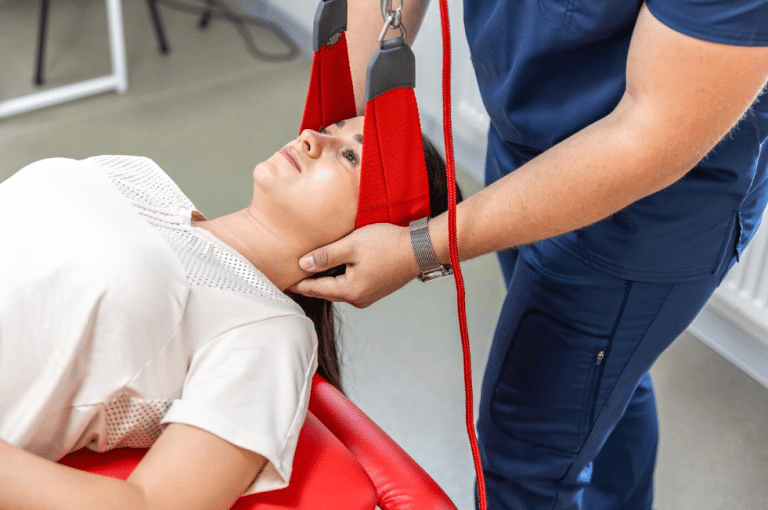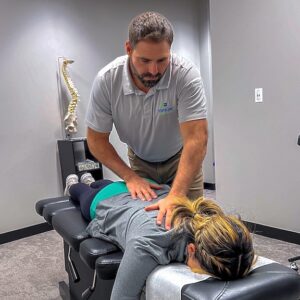Are persistent headaches hindering your daily life? Seeking relief from these nagging pains often leads people to explore various remedies, and one such promising avenue is chiropractic care. A chiropractor, specializing in chiropractic techniques, aims to alleviate headaches through non-invasive, drug-free methods. If you’re searching for a chiropractor near you who offers chiropractic services, Evolve Chiropractic West Schaumburg might be your solution.
Understanding Chiropractic Care and Its Approach to Headaches
Chiropractic care, founded on the belief that optimal spinal alignment is integral to holistic well-being, operates on the premise that disruptions in spinal alignment can manifest as various health issues, including headaches. This alternative healthcare approach views headaches not merely as isolated symptoms but as potential manifestations of underlying spinal misalignments, muscle tension, or nerve disturbances. Rather than solely targeting the symptoms, chiropractors focus on identifying and addressing the root causes of headaches.
A proficient chiropractor takes a comprehensive approach to assess your spinal health. Through a thorough examination, which may include spinal assessments, postural evaluations, and possibly imaging studies, they aim to pinpoint areas of misalignment or dysfunction that might contribute to headache occurrences. By understanding the relationship between spinal health and headaches, chiropractors develop tailored treatment plans. These plans incorporate a range of chiropractic techniques aimed at realigning the spine, relieving muscle tension, and optimizing nerve function, ultimately aiming to mitigate headache symptoms and provide lasting relief. The personalized nature of chiropractic care ensures that treatments are specifically tailored to individual needs, addressing the underlying issues contributing to headaches rather than merely masking the pain.
Chiropractic Techniques for Headache Relief
1. Spinal Adjustment (Spinal Manipulation):
Chiropractors perform spinal adjustments, a central technique in chiropractic care. This process involves applying controlled, sudden force to specific vertebrae that are misaligned or restricted in movement. The goal is to restore proper alignment, improve spinal function, and alleviate tension in the surrounding muscles and nerves. By correcting spinal misalignments, chiropractors aim to reduce nerve irritation and improve blood flow, potentially leading to a decrease in headache frequency and intensity.
2. Soft Tissue Therapy:
Chiropractors employ various soft tissue therapies to target muscle tension and tightness commonly associated with headaches. Techniques such as massage therapy, trigger point therapy, and myofascial release are used to manipulate soft tissues, release muscle knots, and alleviate muscle spasms. These therapies help in improving blood circulation, reducing inflammation, and restoring flexibility, all of which can contribute to relieving headache symptoms by addressing muscular components contributing to headaches.
3. Cranial Adjustments:
Some chiropractors use gentle cranial manipulation techniques to address certain types of headaches. Through subtle adjustments, they aim to improve the movement and alignment of cranial bones. This technique may help relieve pressure on sensitive structures within the skull, potentially reducing certain headache types, particularly those originating from cranial tension or imbalances.
4. Mobilization Techniques:
Chiropractors utilize mobilization techniques involving gentle stretching and movement of the affected joints and muscles. Unlike spinal adjustments, mobilization techniques involve more prolonged, rhythmic movements to improve joint function, reduce stiffness, and enhance flexibility in the spine. These techniques can assist in restoring normal joint movement and muscle function, contributing to reduced headache frequency and intensity.
5. Posture Correction:
Chiropractors focus on correcting poor posture that can contribute to spinal misalignments and muscle tension, leading to headaches. Through detailed assessments and personalized recommendations, they educate patients on proper posture habits during daily activities, work, and sleep. By addressing poor posture habits, chiropractors aim to reduce strain on the spine, thus alleviating headaches caused by postural imbalances.
6. Ergonomic Recommendations:
Chiropractors provide ergonomic advice tailored to patients’ workstations and daily activities. They suggest adjustments in seating, computer ergonomics, and other environmental factors to promote proper spinal alignment. Implementing ergonomic changes reduces stress on the spine and muscles, potentially decreasing headache occurrences associated with poor ergonomic setups.
7. Lifestyle Modifications:
Chiropractors emphasize the importance of lifestyle modifications to support overall health and headache management. They offer guidance on stress management techniques, the importance of staying hydrated, regular exercise routines, and maintaining a balanced diet. Lifestyle changes can complement chiropractic treatments, addressing underlying factors contributing to headaches.
8. Stress Reduction Techniques:
Stress is a common trigger for headaches, and chiropractors integrate stress reduction techniques into their treatment plans. These techniques include relaxation exercises, deep breathing, meditation, or mindfulness practices. By teaching patients effective stress management, chiropractors aim to reduce muscle tension and stress-related headaches.
9. Nutritional Counseling:
Chiropractors may provide nutritional guidance, identifying potential dietary triggers that can exacerbate headaches. They might recommend dietary adjustments, suggest supplements, or advise on hydration levels to help manage headaches. Understanding how certain foods or nutritional deficiencies impact headaches can be instrumental in reducing their frequency and severity.
10. Patient Education and Self-Care:
Chiropractors empower patients by educating them about headache triggers, preventive measures, and self-care strategies. Patients learn about recognizing early signs of tension, adopting proper relaxation techniques, and utilizing heat or ice therapy when needed. Equipping patients with knowledge and tools for self-care enhances the effectiveness of chiropractic treatments and fosters long-term headache relief.
11. Neurological Rehabilitation:
Chiropractors may employ neurological rehabilitation techniques targeting the central nervous system to address headaches. These methods include specific exercises, sensory stimulation, or brain-based therapies aimed at improving brain function and reducing neurological sensitivities associated with certain headache types. By focusing on neurological aspects, chiropractors aim to modulate pain perception and enhance the body’s ability to manage headaches.
12. Acupuncture and Acupressure:
Some chiropractors integrate acupuncture or acupressure techniques as adjunct therapies for headache relief. Acupuncture involves the insertion of fine needles into specific points on the body, stimulating nerve-rich areas to promote pain relief and relaxation. Acupressure involves applying pressure to specific points without needles. Both methods can help in releasing tension, improving blood flow, and reducing headache symptoms.
13. Instrument-Assisted Adjustments:
Chiropractors utilize specialized instruments, such as an activator or an adjusting tool, for precise and gentle spinal adjustments. These tools deliver controlled impulses to targeted areas of the spine, facilitating adjustments without the need for manual manipulation. Instrument-assisted adjustments can be particularly beneficial for patients who prefer a gentler approach or have specific conditions that require a more controlled technique.
14. SOT (Sacro-Occipital Technique):
SOT is a chiropractic technique that focuses on the relationship between the sacrum (base of the spine) and the occiput (base of the skull). Chiropractors employing SOT use blocks or wedges placed under the patient’s pelvis to restore balance and alignment in the spine. By addressing pelvic imbalance and its impact on spinal health, SOT aims to alleviate headaches caused by sacroiliac joint dysfunction or spinal misalignments.
Finding Chiropractic Services Near You
Conduct thorough research when looking for a chiropractor. Utilize online directories, search engines, and healthcare provider listings to gather a comprehensive list of potential chiropractors in your area. Additionally, seek recommendations from acquaintances, family, or friends who have had positive experiences with chiropractic care. Pay attention to specific details about their experiences, such as the chiropractor’s demeanor, treatment effectiveness, and the overall atmosphere of the clinic.
Check Credentials and Experience:
Dive into the chiropractor’s background. Verify their licensing, certifications, and education to ensure they have undergone proper training. Evaluate their experience, especially regarding conditions similar to yours. Some chiropractors might specialize in certain areas such as sports injuries, pregnancy-related issues, or specific techniques like spinal adjustments or soft tissue therapy. A seasoned practitioner with relevant expertise can provide targeted and effective care.
Specializations and Techniques:
Explore the chiropractor’s specialization and preferred techniques. Some chiropractors might focus on particular demographics or health concerns. For instance, pediatric chiropractors cater to children, while others specialize in treating athletes or seniors. Understand their approach to care and inquire about the techniques they use. Whether it’s spinal manipulation, massage therapy, or other modalities, choose a chiropractor whose methods align with your comfort and needs.
Location and Accessibility:
Assess the convenience of the chiropractic clinic’s location. Consider proximity to your home or workplace, as well as ease of access via public transportation or parking availability. A conveniently located clinic encourages regular visits and reduces stress associated with commuting, fostering consistency in your treatment plan.
Consultation and Communication:
Schedule an initial consultation with potential chiropractors. Use this opportunity to assess their communication style, listening skills, and willingness to address your concerns. A good chiropractor will take the time to understand your medical history, discuss treatment options, and involve you in decision-making. Pay attention to how well they explain complex concepts in simple terms and how comfortable you feel discussing your health concerns with them.
Treatment Plans and Approach:
Inquire about the chiropractor’s treatment philosophy and approach. A reputable practitioner will craft a personalized treatment plan tailored to your specific condition, preferences, and health goals. They should emphasize a holistic approach to wellness, addressing not just the symptoms but also the underlying causes of your health issues.
Technology and Facilities:
Evaluate the clinic’s facilities and available technology. Modern equipment and updated facilities can enhance the quality of care and contribute to a more comfortable treatment experience. Consider factors such as the cleanliness of the clinic, the condition of equipment used during treatments, and the availability of advanced technologies that might benefit your treatment.
Patient Reviews and Testimonials:
Delve into patient reviews and testimonials on various platforms. These firsthand accounts offer valuable insights into the chiropractor’s effectiveness, bedside manner, and the overall patient experience. Look for patterns in the reviews, paying attention to comments on the effectiveness of treatments, the friendliness of the staff, waiting times, and the overall atmosphere of the clinic.
Chiropractic care is an alternative approach that many find effective in alleviating headaches. By targeting the root causes through various chiropractic techniques, these practitioners aim to provide long-term relief without relying on medication. If you’re considering this natural and non-invasive method for headache relief, seeking a chiropractor near you who specializes in chiropractic care, such as Evolve Chiropractic West Schaumburg, could be a step toward a headache-free life.
In your pursuit of relief from headaches, exploring chiropractic techniques might just be the solution you’ve been searching for. Consult a professional chiropractor near me to embark on a journey toward holistic wellness and freedom from persistent headaches.
2644 W Schaumburg Rd, Schaumburg, IL 60194, United States
847-278-1574
https://myevolvechiropractor.com/locations/chiropractor-west-schaumburg-il/





